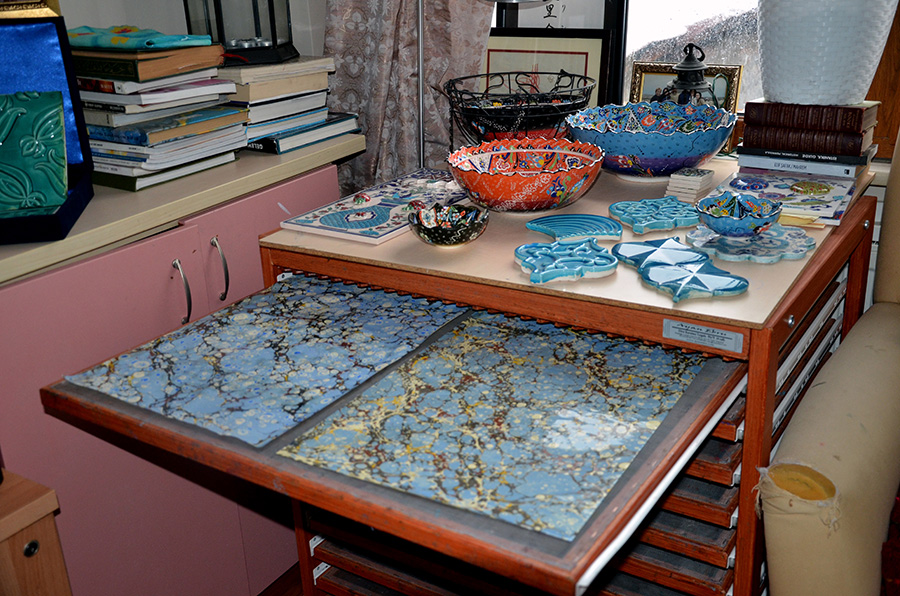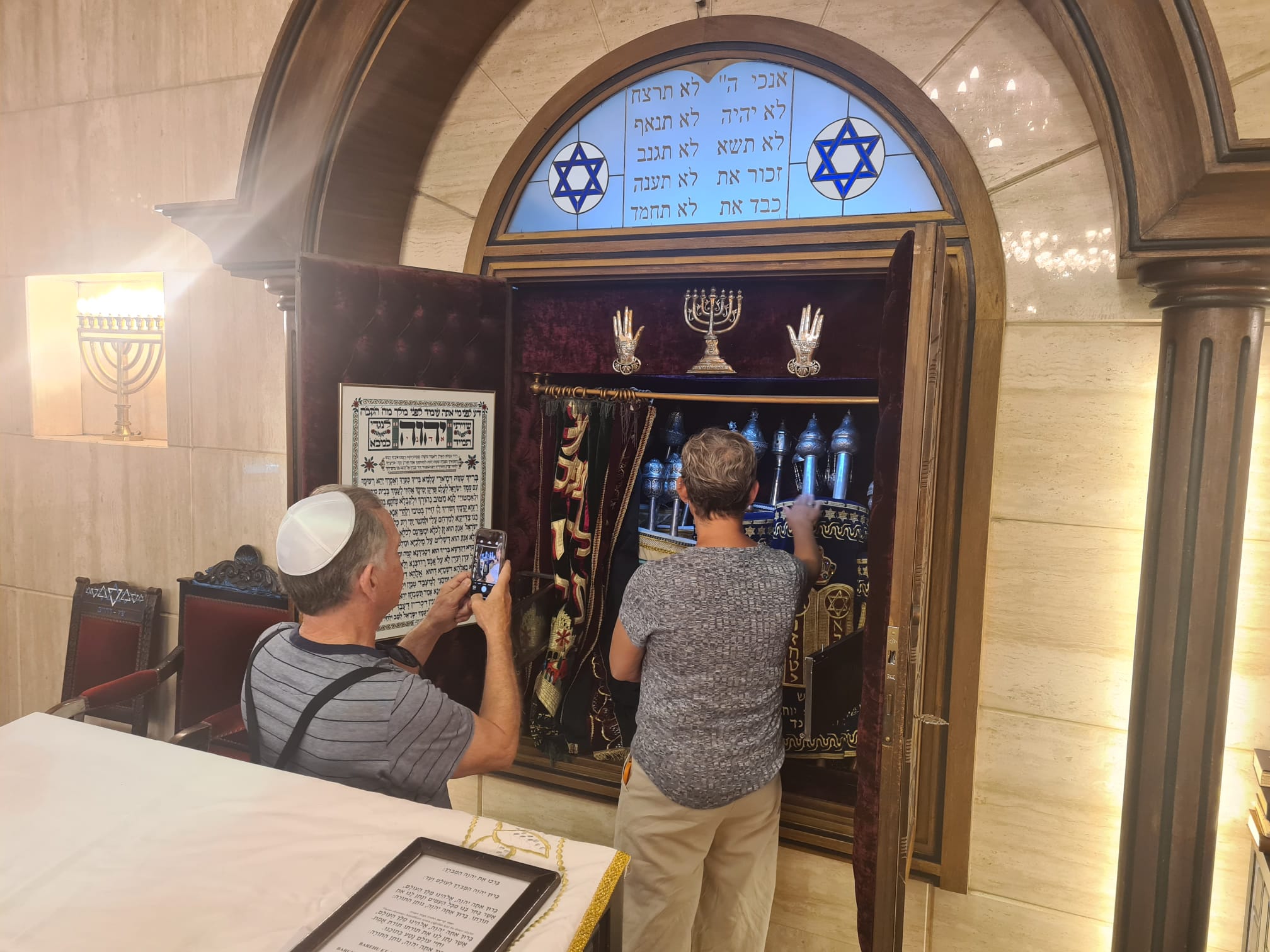Restoration of Yanbol Synagogue Finished in Balat Istanbul / 2025
From Bulgaria to Balat: “The Light of Yanbol”
A hidden treasure found in “forgotten rooms”
During the restoration work in one of the only two active synagogues remaining in Balat—Yanbol Synagogue—a hidden treasure dating back to the Byzantine period was discovered in a long-forgotten room.
Most of the objects, dating from the late 19th and early 20th centuries, are now exhibited under the name “The Light of Yanbol – Luz De Yanbol” at the synagogue since July.
Nisya İşman Allovi, Director of the Quincentennial Foundation Museum of Turkish Jews and curator of The Light of Yanbol, says:
“Every single item in the collection is valuable not only for its ritual purpose but also for its cultural memory.”
From Bulgaria to Balat
Once home to twelve synagogues, Istanbul’s Balat district—where Jews once lived densely—today has only two functioning synagogues: Ahrida and Yanbol. Four synagogues await restoration, while the others are in ruins.
The Yanbol Synagogue, whose construction date is uncertain but known to have existed during the Byzantine period, was founded by Jews who migrated to Balat from Yambol, a town in Bulgaria.
Due to waves of migration over time, the synagogue’s congregation gradually shrank, and now only one Jewish person lives in Balat. Yet, descendants of those who once prayed in Yanbol still return for ceremonies to keep it alive.
Shabbat prayers are held every Saturday at Yanbol, while holiday prayers take place in the larger Ahrida. The synagogue’s cantor (trained to lead the melodic prayers) leads the service, attended by about 45 people.
The forgotten room
About a year and a half ago, restoration work began at the Yanbol Synagogue. During this process, a forgotten upper room, closed for decades, was discovered.
Inside were hundreds of items—books, shiviti (decorative prayer plaques), rimonim (ornamental Torah finials), mapot (Torah covers), parohet (Torah curtains), faşa, besamim (spice boxes), and Sefer Torah fabrics—all carefully restored.
Each object, material, and section of the synagogue was revived with great care.
To preserve and showcase this rediscovered cultural heritage, the restored objects were transformed into an exhibition titled “The Light of Yanbol – Luz De Yanbol”, displayed in a room opposite the synagogue.
Both the synagogue and the exhibition reopened in July after the restoration’s completion.
Journalist Marta Sömek and photographer Berge Arabian, guided by the synagogue’s Kohen (priest), visited the historical site.
Inside the synagogue
The courtyard of Yanbol Synagogue, which carries traces of the Byzantine era, includes the synagogue itself, the exhibition room, a kitchen, and a winter garden where breakfast is held after ceremonies.
Upon entering, visitors are greeted by the painting “From Yambol, Bulgaria to Balat Yanbol” by Seyfi İşman.
Inside, the Teva—the platform from which the rabbi reads the Torah—catches the eye first. Opposite it stands the Aron Kodesh, a beautifully carved wooden cabinet with two doors, ornamented with symbols and topped by the Tablets of the Ten Commandments.
Illuminated by menorahs (seven-branched candelabra) and adorned with paintings of Torah verses, the synagogue radiates a mystical atmosphere.
The exhibition in the “forgotten room,” now The Light of Yanbol, reveals a deeply moving legacy of Jewish culture. Every restored religious object and artwork bears witness to the traces of history.
Among them are 18 rimonim—apple, pear, and tower-shaped Torah ornaments symbolizing abundance and inspired by the pomegranate, a beloved motif in Jewish art.
One and a half years of effort
Displayed in the exhibition are Besamim boxes (incense containers used during the Havdalah ceremony at the end of Shabbat), Sefer Torah scrolls (handwritten Torahs), Tsedakah charity boxes, eight Mapot (Torah tablecloths), Parohet curtains (covering the Torah ark), and Hebrew calligraphic panels.
It’s astonishing how objects forgotten for decades in a single room now appear as if newly created after meticulous restoration.
After the tour, curator Nisya İşman Allovi, Director of the Quincentennial Foundation Museum of Turkish Jews, shared more details:
Interview with Nisya İşman Allovi
Many ritual objects are displayed in the exhibition. From what period do they date?
During the restoration of Yanbol Synagogue, an unused attic was found—a long-forgotten storage area. When we discovered the religious textiles, silver items, shivitis, old documents, and books inside, we realized we had stumbled upon a true treasure.
This discovery marked the beginning of the story of these “forgotten rooms.” Most of the artifacts date from the late 19th and early 20th centuries.
How were the objects so well preserved, and how did the exhibition idea arise?
The idea came from Moris Levi, President of the Ahrida Synagogues Foundation. The Quincentennial Foundation Museum was consulted, and thanks to our experience with similar collections, the process advanced quickly.
First, the items were carefully catalogued, followed by an extensive 18-month restoration process. Textiles, metals, and paper materials were all restored with expert supervision. Once conservation was complete, the works were first safeguarded at the museum, then moved back to the synagogue for exhibition.
What kind of collection awaits visitors?
All the objects on display are ritual materials used during synagogue prayers. Examples include the Torah mantle (mapa), the crown (keter), and rimonim decorations; the Parohet curtain; the pointer rod (puntero) used to follow Torah readings; shiviti plaques with Torah quotations; oil lamps, spice boxes (besamim), charity boxes (tsedakah), and Torah wrapping fabrics (faşa).
Each carries immense cultural and ritual significance.
The exhibition also features paintings with Torah verses—what are they and what do they symbolize?
These are known as Shiviti. They are placed in synagogues to remind worshippers of the divine presence.
Typically, they feature the verse: “I have set the Lord always before me.” This serves to help the worshipper attain a proper spiritual mindset during prayer.
Some examples display the Tetragrammaton (Divine Name of God) or the Menorah symbol. Positioned above the Teva table, these panels are regarded as spiritual reinforcements of worship.
Why was organizing such an exhibition important for you?
The Ahrida and Yanbol Synagogues are two of the most important surviving witnesses of Istanbul’s Jewish heritage.
Still functioning as places of worship, they testify to a once-vibrant communal life.
In museology, we often ask “Where did these objects originate from?”—but in this exhibition, that question isn’t necessary.
We already know that all these items were gradually collected from now-closed synagogues of Balat and preserved under the Ahrida Foundation.
For us, contributing to this site that bears the legacy of Romaniote and Sephardic Jewish communities was both meaningful and a responsibility.




